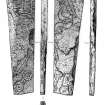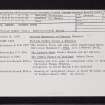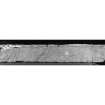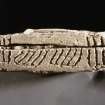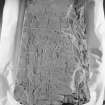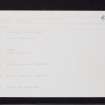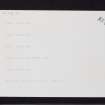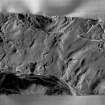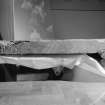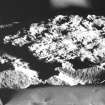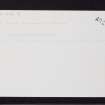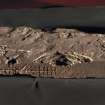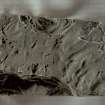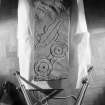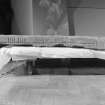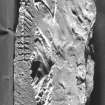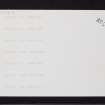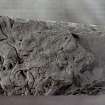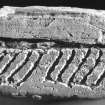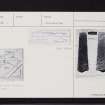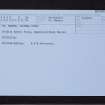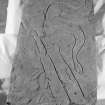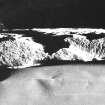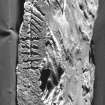Pricing Change
New pricing for orders of material from this site will come into place shortly. Charges for supply of digital images, digitisation on demand, prints and licensing will be altered.
St Madoes, Inchyra Stone
Inhumation (Period Unknown), Ogham Inscribed Stone (Early Medieval), Pictish Symbol Stone (Pictish)
Site Name St Madoes, Inchyra Stone
Classification Inhumation (Period Unknown), Ogham Inscribed Stone (Early Medieval), Pictish Symbol Stone (Pictish)
Alternative Name(s) Inchyra House Policies
Canmore ID 28250
Site Number NO12SE 9
NGR NO 1904 2120
Datum OSGB36 - NGR
Permalink http://canmore.org.uk/site/28250
- Council Perth And Kinross
- Parish St Madoes
- Former Region Tayside
- Former District Perth And Kinross
- Former County Perthshire
Inchyra, St Madoes, Perthshire, Pictish symbol stone with ogam inscriptions.
Measurements: H 1.60m, W 0.44m, D 0.09m
Stone type: very finely grained sandstone
Place of discovery: NO 1904 2120
Present location: Perth Art Gallery & Museum (5/45)
Evidence for discovery: found during ploughing in 1949, lying flat over a small cairn of boulders enclosing an inhumation burial.
Present condition: the broader end is broken and there is damage to the edges of the slab. Parts of the surface have flaked off, though some fragments were recovered at the time of the discovery. The surviving carving is in good condition.
Description
This tapering slab is incised with three sets of two symbols, each apparently carved by a different hand, and three ogam inscriptions of varying length accompany each set of symbols. This association is discussed very fully in Forsyth 1996. The symbols are arranged at either end of the slab on both broad faces, and the longest inscription runs along one narrow face and along the short face at the narrow end of the slab. The symbol sets comprise a fish and a serpent, a tuning fork and a mirror and a double disc and a fish.
Date: seventh or eighth century.
References: Stevenson 1959; RCAHMS 1994, 95; Forsyth 1996, 333-59; Fraser 2009, no 185.
Compiled by A Ritchie 2016
N012SE 9 1904 2120
Now in Perth Museum and Art Gallery.
(Undated) information in NMRS.
Information from Thomas McLaren, 'Drawing and site plan of sculptured stone at Inchyra, 1945' (originals in Perth Museum and art Gallery) and also 'Drawing of sculptured stones in field 50 yards south of Inchyra House; 1945'. Both drawings held by the Scottish Record Office.
(Undated) information in NMRS.
This slab, found during ploughing in 1945, was associated with a series of boulders covering an inhumation burial; the slab now in Perth Museum (5/45) bears on one side a double disc symbol and a fish at one end, a 'tuning fork' and mirror (unfinished) at the other, and on the other side a fish and serpent.
There is an ogam inscription on one side and at the top.
R B K Stevenson 1959; F T Wainwright 1961; H Coutts 1970; RCAHMS 1985.
Field Visit (10 June 1964)
Nothing remains at the site, which was pointed out on the ground at NO 1904 2120 by Mr. Chalmers, 23 Druid's Way, Pitfour, the discoverer of the burial in 1945.
Visited by OS, 10 June 1964.
Note (15 December 1992)
In February 1945 a grave containing a skeleton was discovered in the course of ploughing in what had formerly been parkland 100m S of Inchyra House; the skeletal remains, which included the upper part of a skull, an arm bone and shoulder socket, were re-buried without detailed examination; they had been covered by a large flat slab and forty-nine water-rolled stones. The slab was found to be decorated on both faces with Pictish symbols and on one side and one end with ogam inscriptions; it is now in Perth Museum (PMAG 5/1945). One end of one side is decorated with a double-disc symbol and a fish, while at the other end of the same side there appear to be two unfinished symbols: a 'tuning-fork' and a mirror. On the other side of the stone, a fish and a snake have been incised. There are four ogam inscriptions; no interpretation as to the meaning of the inscriptions can, however, be offered.
Information from RCAHMS (JRS) 15 December 1992.
Publication Account (1997)
Class I symbol stone. One face has a double-disc above a salmon at one end,with a rectangle above a mirror at the other.On the other face is a salmon beside a serpent,and some Ogam strokes. The edge of the stone has further Ogam writing.
A Mack 1997.




































